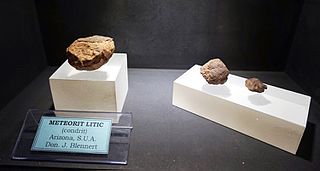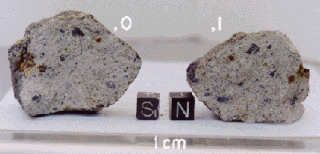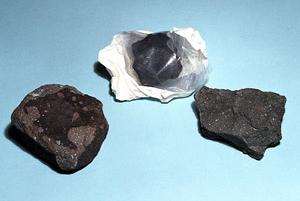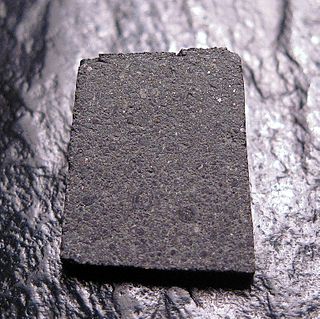
A meteorite classification system attempts to group similar meteorites and allows scientists to communicate with a standardized terminology when discussing them. Meteorites are classified according to a variety of characteristics, especially mineralogical, petrological, chemical, and isotopic properties.

A chondrule is a round grain found in a chondrite. Chondrules form as molten or partially molten droplets in space before being accreted to their parent asteroids. Because chondrites represent one of the oldest solid materials within the Solar System and are believed to be the building blocks of the planetary system, it follows that an understanding of the formation of chondrules is important to understand the initial development of the planetary system.

C-type (carbonaceous) asteroids are the most common variety, forming around 75% of known asteroids. They are distinguished by a very low albedo because their composition includes a large amount of carbon, in addition to rocks and minerals. They occur most frequently at the outer edge of the asteroid belt, 3.5 astronomical units (AU) from the Sun, where 80% of the asteroids are of this type, whereas only 40% of asteroids at 2 AU from the Sun are C-type. The proportion of C-types may actually be greater than this, because C-types are much darker than most other asteroid types except for D-types and others that are mostly at the extreme outer edge of the asteroid belt.

A chondrite is a stony (non-metallic) meteorite that has not been modified, by either melting or differentiation of the parent body. They are formed when various types of dust and small grains in the early Solar System accreted to form primitive asteroids. Some such bodies that are captured in the planet’s gravity well become the most common type of meteorite by arriving on a trajectory toward the Earth’s surface. Estimates for their contribution to the total meteorite population vary between 85.7% and 86.2%.
Kassandra is a large and dark main-belt asteroid. It belongs to the rare class T. It was discovered by C. H. F. Peters on July 23, 1871, and is named after Cassandra, the prophetess in the tales of the Trojan War. The asteroid is featured in the 2009 film Meteor, in which it is split in two by a comet, and set on a collision course with Earth.

Orgueil is a scientifically important carbonaceous chondrite meteorite that fell in southwestern France in 1864.

Carbonaceous chondrites or C chondrites are a class of chondritic meteorites comprising at least 8 known groups and many ungrouped meteorites. They include some of the most primitive known meteorites. The C chondrites represent only a small proportion (4.6%) of meteorite falls.

The Murchison meteorite is a meteorite that fell in Australia in 1969 near Murchison, Victoria. It belongs to a group of meteorites rich in organic compounds. Due to its mass and the fact that it was an observed fall, the Murchison meteorite is one of the most studied of all meteorites.
An asteroid spectral type is assigned to asteroids based on their emission spectrum, color, and sometimes albedo. These types are thought to correspond to an asteroid's surface composition. For small bodies that are not internally differentiated, the surface and internal compositions are presumably similar, while large bodies such as Ceres and Vesta are known to have internal structure. Over the years, there has been a number of surveys that resulted in a set of different taxonomic systems such as the Tholen, SMASS and Bus–DeMeo classification.

Howardites are achondritic stony meteorites that originate from the surface of the asteroid 4 Vesta, and as such are part of the HED meteorite clan. There are about 200 distinct members known.

The Tagish Lake meteorite fell at 16:43 UTC on 18 January 2000 in the Tagish Lake area in northwestern British Columbia, Canada.
Kaidun is a meteorite that fell on 3 December 1980 on a Soviet military base near what is now Al-Khuraybah in Yemen. A fireball was observed travelling from the northwest to the southeast, and a single stone weighing about 2 kilograms (4.4 lb) was recovered from a small impact pit.

The Bench Crater meteorite is a meteorite discovered on the Moon by Apollo 12 astronauts in 1969. It is part of the friable basalt lunar sample 12037. Found on the north-west rim of the Bench Crater, it is the first meteorite to be discovered on a Solar System body other than the Earth. Its diameter is just a few millimeters. It is listed as a carbonaceous chondrite by the Meteoritical Society.

The Allende meteorite is the largest carbonaceous chondrite ever found on Earth. The fireball was witnessed at 01:05 on February 8, 1969, falling over the Mexican state of Chihuahua. After breaking up in the atmosphere, an extensive search for pieces was conducted and over 2 tonnes (tons) of meteorite were recovered. The availability of large quantities of samples of the scientifically-important chondrite class has enabled numerous investigations by many scientists; it is often described as "the best-studied meteorite in history." The Allende meteorite has abundant, large calcium-aluminium-rich inclusions (CAI), which are among the oldest objects formed in the Solar System.

CI chondrites, sometimes C1 chondrites, are a group of rare stony meteorites belonging to the carbonaceous chondrites. Samples have been discovered in France, Canada, India, and Tanzania. Compared to all the meteorites found so far, their chemical composition most closely resembles the elemental distribution in the sun's photosphere.

Moss is a carbonaceous chondrite meteorite that fell over the communities of Rygge and Moss in Østfold county, southeast southern Norway in the morning of midsummer day, July 14, 2006.
CI1 fossils refer to alleged morphological evidence of microfossils found in five CI1 carbonaceous chondrite meteorite fall: Alais, Orgueil, Ivuna, Tonk and Revelstoke. The research was published in March 2011 in the fringe Journal of Cosmology by Richard B. Hoover, an engineer. However, NASA distanced itself from Hoover's claim and his lack of expert peer-reviews.
This is a glossary of terms used in meteoritics, the science of meteorites.

Fifteen pieces of the Kainsaz meteorite were seen to fall near Kainsaz, Muslyumovo, Tatarstan on September 13, 1937. The largest weighed 102.5 kilograms (226 lb), the total weight was ~200 kilograms (440 lb). As of January 2013 pieces were on sale for ~US$100/g. Kainsaz is the only observed fall in Tatarstan.
CM chondrites are a group of chondritic meteorites which resemble their type specimen, the Mighei meteorite. The CM is the most commonly recovered group of the 'carbonaceous chondrite' class of meteorites, though all are rarer in collections than ordinary chondrites.














